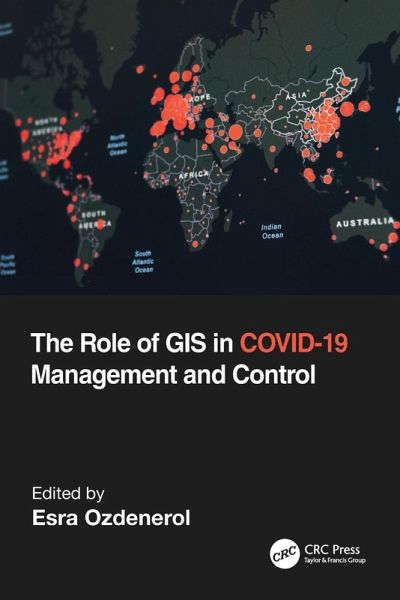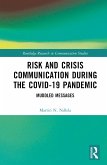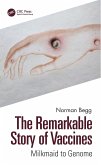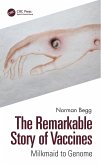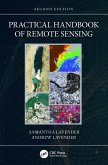The Role of GIS in COVID-19 Management and Control
Herausgeber: Ozdenerol, Esra
The Role of GIS in COVID-19 Management and Control
Herausgeber: Ozdenerol, Esra
- Broschiertes Buch
- Merkliste
- Auf die Merkliste
- Bewerten Bewerten
- Teilen
- Produkt teilen
- Produkterinnerung
- Produkterinnerung
Edited by medical geographer and GIS Professor Dr. Esra Ozdenerol, this book highlights key GIS capabilities and lessons learned during the COVID-19 response and can help communities prepare for the next crisis. 12 global projects are discussed with a multidisciplinary approach, illustrating the role of GIS in crisis management.
Andere Kunden interessierten sich auch für
![Risk and Crisis Communication During the COVID-19 Pandemic Risk and Crisis Communication During the COVID-19 Pandemic]() Martin N. NdlelaRisk and Crisis Communication During the COVID-19 Pandemic159,99 €
Martin N. NdlelaRisk and Crisis Communication During the COVID-19 Pandemic159,99 €![The Remarkable Story of Vaccines The Remarkable Story of Vaccines]() Norman BeggThe Remarkable Story of Vaccines28,99 €
Norman BeggThe Remarkable Story of Vaccines28,99 €![COVID-19 in Brooklyn COVID-19 in Brooklyn]() Jerome KraseCOVID-19 in Brooklyn40,99 €
Jerome KraseCOVID-19 in Brooklyn40,99 €![The Remarkable Story of Vaccines The Remarkable Story of Vaccines]() Norman BeggThe Remarkable Story of Vaccines69,99 €
Norman BeggThe Remarkable Story of Vaccines69,99 €![Science Communication in a Crisis Science Communication in a Crisis]() Christopher ReddyScience Communication in a Crisis183,99 €
Christopher ReddyScience Communication in a Crisis183,99 €![Practical Handbook of Remote Sensing Practical Handbook of Remote Sensing]() Samantha LavenderPractical Handbook of Remote Sensing93,99 €
Samantha LavenderPractical Handbook of Remote Sensing93,99 €![Breathless Breathless]() David QuammenBreathless10,99 €
David QuammenBreathless10,99 €-
-
-
Edited by medical geographer and GIS Professor Dr. Esra Ozdenerol, this book highlights key GIS capabilities and lessons learned during the COVID-19 response and can help communities prepare for the next crisis. 12 global projects are discussed with a multidisciplinary approach, illustrating the role of GIS in crisis management.
Hinweis: Dieser Artikel kann nur an eine deutsche Lieferadresse ausgeliefert werden.
Hinweis: Dieser Artikel kann nur an eine deutsche Lieferadresse ausgeliefert werden.
Produktdetails
- Produktdetails
- Verlag: Taylor & Francis Ltd
- Seitenzahl: 290
- Erscheinungstermin: 19. Dezember 2024
- Englisch
- Abmessung: 156mm x 233mm x 17mm
- Gewicht: 530g
- ISBN-13: 9781032129761
- ISBN-10: 103212976X
- Artikelnr.: 72111787
- Herstellerkennzeichnung
- Libri GmbH
- Europaallee 1
- 36244 Bad Hersfeld
- gpsr@libri.de
- Verlag: Taylor & Francis Ltd
- Seitenzahl: 290
- Erscheinungstermin: 19. Dezember 2024
- Englisch
- Abmessung: 156mm x 233mm x 17mm
- Gewicht: 530g
- ISBN-13: 9781032129761
- ISBN-10: 103212976X
- Artikelnr.: 72111787
- Herstellerkennzeichnung
- Libri GmbH
- Europaallee 1
- 36244 Bad Hersfeld
- gpsr@libri.de
Dr. Esra Ozdenerol is a professor in the Department of Earth Sciences at the University of Memphis and has been since 2003. She is also affiliated with the Departments of Preventive Medicine and Health Outcome Policy of the University of Tennessee Health Science Center. She is the director of the GIS Certificate Program at the University of Memphis, and she directs the Spatial Analysis and Geographic Education Laboratory in the Department of Earth Sciences. Dr. Ozdenerol was the associate director of Benjamin L. Hooks Institute for Social Change at the University of Memphis from 2010 to 2013. She earned her doctorate degree in Geography in 2000 and her Master of Landscape Architecture degree in 1996 from the Louisiana State University. She earned her Bachelor of Science degree in Landscape Architecture and Agricultural Engineering from the University of Ankara, Turkey. Before joining the University of Memphis, she was an assistant professor of architecture at Florida International University in Miami from 2000 to 2003. Dr. Ozdenerol specializes in geographic information systems and has served as a technical consultant to various public, governmental, and international agencies. Her latest publications are on studies about spatial health inequalities. She has published two books with Taylor & Francis - Spatial Health Inequalities: Adapting GIS Tools and Data Analysis (2016) and Gender Inequalities: GIS approaches to Gender Analysis (2021).
1. The Role of GIS in COVID-19 Management and Control 2. Information
Access as a Strategy to Overcome Health Inequities in the Context of
COVID-19 3. Spatial Pattern of COVID-19 Positivity Rates in Indonesia
during Local Restriction Phase: A Case study of Jakarta and Surabaya City
4. Investigating Spatial Relationships of Age and Comorbidities on COVID-19
Spread Using Geographically Weighted Regression 5. Spatiotemporal Patterns
of Covid-19: A District-level Analysis of Kerala, India, 2020-2021 6. The
2020 Hurricanes, Internal Displacements and COVID-19 in Latin America and
the Caribbean Countries: Lessons Learned for Disaster Risk Reduction 7.
Hot Spot Tracker: Detecting and Visualizing the Types of Spatiotemporal Hot
Spots of COVID-19 in the United States 8. Lifestyle Effects on the Risk
of Transmission of COVID-19 in the United States: Evaluation of Market
Segmentation Systems 9. A Bibliometric Review of Research on the Role of
GIS in COVID19 Pandemic Control and Management: Science Mapping the
Literature, 2020 - 2022 10. The Use of Geographic Information Systems to
Shape COVID Policies Regarding Masking and Distancing with A Partially
Vaccinated Population 11. Using GIS to Map Women's Health, Well-being and
Economic Opportunities in the Context of COVID-19 12. The Effects of
Lifestyle on COVID-19 Vaccine Hesitancy in the United States: An Analysis
of Market Segmentation 13. A Gendered Approach to Examining Pandemic
Induced Livelihood Crisis in the Informal Sector: the Case of Female
Domestic Workers in Titwala
Access as a Strategy to Overcome Health Inequities in the Context of
COVID-19 3. Spatial Pattern of COVID-19 Positivity Rates in Indonesia
during Local Restriction Phase: A Case study of Jakarta and Surabaya City
4. Investigating Spatial Relationships of Age and Comorbidities on COVID-19
Spread Using Geographically Weighted Regression 5. Spatiotemporal Patterns
of Covid-19: A District-level Analysis of Kerala, India, 2020-2021 6. The
2020 Hurricanes, Internal Displacements and COVID-19 in Latin America and
the Caribbean Countries: Lessons Learned for Disaster Risk Reduction 7.
Hot Spot Tracker: Detecting and Visualizing the Types of Spatiotemporal Hot
Spots of COVID-19 in the United States 8. Lifestyle Effects on the Risk
of Transmission of COVID-19 in the United States: Evaluation of Market
Segmentation Systems 9. A Bibliometric Review of Research on the Role of
GIS in COVID19 Pandemic Control and Management: Science Mapping the
Literature, 2020 - 2022 10. The Use of Geographic Information Systems to
Shape COVID Policies Regarding Masking and Distancing with A Partially
Vaccinated Population 11. Using GIS to Map Women's Health, Well-being and
Economic Opportunities in the Context of COVID-19 12. The Effects of
Lifestyle on COVID-19 Vaccine Hesitancy in the United States: An Analysis
of Market Segmentation 13. A Gendered Approach to Examining Pandemic
Induced Livelihood Crisis in the Informal Sector: the Case of Female
Domestic Workers in Titwala
1. The Role of GIS in COVID-19 Management and Control 2. Information
Access as a Strategy to Overcome Health Inequities in the Context of
COVID-19 3. Spatial Pattern of COVID-19 Positivity Rates in Indonesia
during Local Restriction Phase: A Case study of Jakarta and Surabaya City
4. Investigating Spatial Relationships of Age and Comorbidities on COVID-19
Spread Using Geographically Weighted Regression 5. Spatiotemporal Patterns
of Covid-19: A District-level Analysis of Kerala, India, 2020-2021 6. The
2020 Hurricanes, Internal Displacements and COVID-19 in Latin America and
the Caribbean Countries: Lessons Learned for Disaster Risk Reduction 7.
Hot Spot Tracker: Detecting and Visualizing the Types of Spatiotemporal Hot
Spots of COVID-19 in the United States 8. Lifestyle Effects on the Risk
of Transmission of COVID-19 in the United States: Evaluation of Market
Segmentation Systems 9. A Bibliometric Review of Research on the Role of
GIS in COVID19 Pandemic Control and Management: Science Mapping the
Literature, 2020 - 2022 10. The Use of Geographic Information Systems to
Shape COVID Policies Regarding Masking and Distancing with A Partially
Vaccinated Population 11. Using GIS to Map Women's Health, Well-being and
Economic Opportunities in the Context of COVID-19 12. The Effects of
Lifestyle on COVID-19 Vaccine Hesitancy in the United States: An Analysis
of Market Segmentation 13. A Gendered Approach to Examining Pandemic
Induced Livelihood Crisis in the Informal Sector: the Case of Female
Domestic Workers in Titwala
Access as a Strategy to Overcome Health Inequities in the Context of
COVID-19 3. Spatial Pattern of COVID-19 Positivity Rates in Indonesia
during Local Restriction Phase: A Case study of Jakarta and Surabaya City
4. Investigating Spatial Relationships of Age and Comorbidities on COVID-19
Spread Using Geographically Weighted Regression 5. Spatiotemporal Patterns
of Covid-19: A District-level Analysis of Kerala, India, 2020-2021 6. The
2020 Hurricanes, Internal Displacements and COVID-19 in Latin America and
the Caribbean Countries: Lessons Learned for Disaster Risk Reduction 7.
Hot Spot Tracker: Detecting and Visualizing the Types of Spatiotemporal Hot
Spots of COVID-19 in the United States 8. Lifestyle Effects on the Risk
of Transmission of COVID-19 in the United States: Evaluation of Market
Segmentation Systems 9. A Bibliometric Review of Research on the Role of
GIS in COVID19 Pandemic Control and Management: Science Mapping the
Literature, 2020 - 2022 10. The Use of Geographic Information Systems to
Shape COVID Policies Regarding Masking and Distancing with A Partially
Vaccinated Population 11. Using GIS to Map Women's Health, Well-being and
Economic Opportunities in the Context of COVID-19 12. The Effects of
Lifestyle on COVID-19 Vaccine Hesitancy in the United States: An Analysis
of Market Segmentation 13. A Gendered Approach to Examining Pandemic
Induced Livelihood Crisis in the Informal Sector: the Case of Female
Domestic Workers in Titwala

